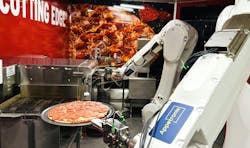Why Automation is Ready for Airport Concessions
What You'll Lean From this Article

-
Why airport concessions are uniquely suited for automation due to persistent labor shortages, extended hours of operation, and high traveler demand.
-
How Appetronix’s autonomous kitchen operates, including its use of robotics, AI, and machine vision to deliver consistent, high-quality food in a fully self-contained system.
-
What safety protocols and certifications are required to deploy food automation in regulated environments like airports.
-
The operational benefits for concessionaires and airports, including predictive maintenance, inventory optimization, and labor efficiency.
-
How scalable and low-risk the model is for airports, with no upfront costs and a revenue-sharing approach designed for fast global expansion.
As passenger demand returns to pre-pandemic levels and labor shortages continue to strain airport concessions, a new solution is quietly cooking up change at John Glenn Columbus International Airport: automation. Appetronix, a robotics and AI-driven food technology company, recently deployed what may be the world’s first fully autonomous pizza kitchen inside an airport. The machine—serving fresh Donatos pizza—is designed to meet high traffic demands while overcoming long-standing labor and operational hurdles that have plagued quick-service airport concessions.
To better understand how automation is poised to reshape airport food service, we spoke with Nipun Sharma, co-founder and CEO of Appetronix, about the technology behind the project, its scalability, and the value it brings to concessionaires and travelers alike.
Airport Business: Let’s start with the foundation. What’s unique about the core technology used in your autonomous kitchen?
Sharma: Traditional kitchens are designed for the human body—five-foot-four average height, two arms, two legs. We took a completely different approach and engineered a system optimized entirely around robotics and automation. Rather than adapting to a human kitchen, we created something closer to a food factory: raw ingredients go in, and a perfectly prepared pizza comes out, made entirely by machines.
AB: How long did it take to develop the system deployed in Columbus?
Sharma: It’s been in development for over four years. The concept, design, prototyping, testing—it was a lengthy journey to reach this point. But launching inside an airport like Columbus is the real milestone.
AB: What metrics are you using to evaluate success in an airport environment?
Sharma: Speed and consistency are key. We built this system to deliver high throughput, much like a busy restaurant kitchen—but without human fatigue or error. Customers want transparency, reliability, and the same quality every time. This kitchen lets them watch the entire food preparation process, from ingredient dispensing to baking to pick-up from a smart locker.
AB: How do you ensure food safety and regulatory compliance?
Sharma: Automation actually allows us to go well beyond normal food safety standards. Our machines are NSF-certified and include sensors that monitor temperature, shelf life, and ingredient freshness. If there’s a failure—say, a fridge loses power—protocols automatically kick in to prevent unsafe food from reaching the customer.
AB: Even with automation, what kind of human support is still required?
Sharma: There’s still a need for people to restock raw ingredients and perform routine cleaning and maintenance. For example, operators remove certain components for dishwashing, just like you’d do with plates in a traditional restaurant. We’ve built inventory alerts and predictive maintenance into the system to streamline all of that.
AB: What were the biggest challenges you faced bringing automation into an airport setting?
Sharma: Airports are tough. Labor is hard to come by, food quality expectations are high, and the environment requires strict compliance. Creating a fully autonomous restaurant that meets brand standards for a company like Donatos meant solving for speed, accuracy, safety, and customer satisfaction all at once. And everything—from order to fulfillment—has to work seamlessly through robotics, AI, and machine vision.
AB: What are the key benefits to airports and concessionaires using this kind of solution?
Sharma: Labor shortage is the number one issue. We’re filling that gap with a solution that can operate 24/7, in compliance-heavy environments like airports. Plus, automation doesn’t call in sick, and it doesn’t make mistakes. If it does, the pizza doesn’t go out. That reliability is a game-changer for operators trying to meet demand with limited staff.
AB: Can customers customize their orders, or is it a fixed menu?
Sharma: Absolutely, and that’s one of the strengths of automation. Machines don’t mind custom requests—they just follow programmed instructions. Humans get thrown off by special orders. Robots don’t. That allows us to offer flexible menus without risking errors.
AB: Is this model scalable to other airports or concession environments?
Sharma: Definitely. It’s designed to scale. We’re already targeting expansion into other airports, hospitals, universities, and office buildings. And because we partner with companies like HMSHost and Compass Group, who already operate in those environments, the rollout is faster and more efficient. It’s about slotting into existing ecosystems.
AB: What would you say to airport directors who are hesitant about automation due to perceived complexity or cost?
Sharma: There’s no cost to the airport. We operate on a revenue-share model. We don’t sell machines—we deploy them and maintain them. So for the airport, there’s no financial risk, just upside. Right now, we have more demand than we can meet, so we’re focused on finding the right partners to help scale responsibly.
AB: What role does AI play beyond the kitchen itself?
Sharma: AI is critical for predictive maintenance, inventory management, and real-time sales forecasting. For instance, if the data shows a flight just landed and foot traffic is increasing, we can preemptively begin cooking the top-selling items to reduce wait times. That level of optimization is something traditional kitchens can’t match.
AB: What’s next for Appetronix?
Sharma: Now that we’ve proven this concept at Columbus, the goal is to scale fast. We’ve already built strong partnerships with HMSHost and others, and we’re preparing to roll out internationally. We’re limited only by our manufacturing capacity at this point. But the roadmap is clear—thousands of locations, all built around the same core promise: fresh, fast, safe food without compromise.
About the Author
Joe Petrie
Editor & Chief
Joe Petrie is the Editorial Director for the Endeavor Aviation Group.
Joe has spent the past 20 years writing about the most cutting-edge topics related to transportation and policy in a variety of sectors with an emphasis on transportation issues for the past 15 years.
Contact: Joe Petrie
Editor & Chief | Airport Business
+1-920-568-8399
>> To download the AviationPros media kits, visit: Marketing Resource Center
>>Check out our aviation magazines: Ground Support Worldwide | Airport Business | Aircraft Maintenance Technology
